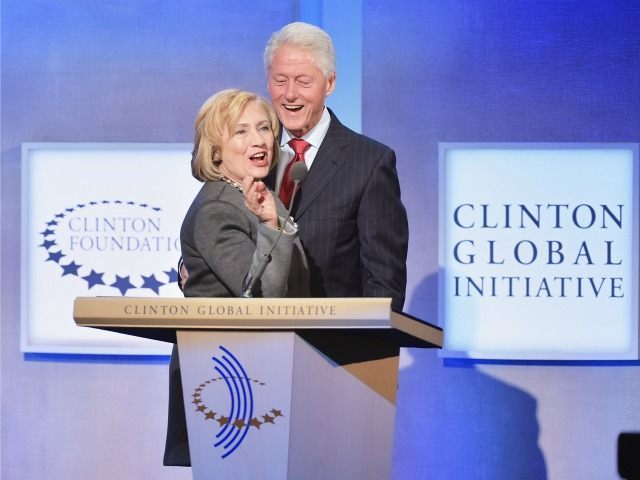Glenn Kessler is the Washington Post’s self-appointed “Fact Checker,” yet his attempt to set the record straight on a 2010 deal to transfer of 20 percent of the U.S.’s uranium capacity to the Russian government is full of omissions and misdirections–errors that cast doubt on Mr. Kessler’s intent.
Kessler says claims that Hillary “gave away” 20 percent of the US’ uranium to Russia are inaccurate. Yet neither statement he cites in the piece claims that the uranium was given away. Kessler is setting up a straw man—a strange thing for an alleged “fact checker” to do. He’s trying to portray the claims about the uranium as though Hillary Clinton personally handed Vladimir Putin a suitcase full of yellowcake.
His depiction also conveniently omits what makes the story truly scandalous–the massive amounts of money that flowed into the Clinton Foundation and the family’s personal coffers from parties tied to the Uranium One deal. The Clinton Foundation received tens of millions of dollars from businessmen tied to the transaction in the time leading up to the deal, of which millions were undisclosed. (Both of these facts have been confirmed by the New York Times.)
This was a clear violation of Secretary Clinton’s memorandum of understanding with the Obama administration that they would disclose all contributions. (Kessler, of course, has no interest in this.) Her husband, former President Bill Clinton, was also paid half a million dollars by a Russian bank with close Kremlin ties in June 2010. Bill even met with Vladimir Putin after the speech.
For Kessler to describe the uranium as being “given away” is to truly misunderstand the transactional nature of the story.
Kessler also claims that the transfer of Uranium One to the Russians is not big deal: Uranium One doesn’t have an export license. Who cares if Russia controls the uranium if it can’t leave the country? But Kessler apparently didn’t even run a Google search in his fact check, because a 2015 New York Times investigation found that uranium mined by the company regularly crossed the border into Canada for processing. That certainly matters more than an export license. But Kessler doesn’t seem to care.
But Kessler’s main objective is to undermine the narrative by challenging the number of “20% of uranium” going to the Russians. The 20 percent figure refers to a 2010 estimate by the Nuclear Regulatory Commission (NRC) that the deal involved 20 percent of the U.S.’s currently licensed in-situ leach (ISL) production capacity, referring to a specific method of obtaining uranium ore. Mr. Kessler correctly points out that subsequent events in the uranium market kept production from ever reaching that level. But that’s irrelevant to the story–CFIUS made its decision in 2010 based on the information available at the time.
In short, his argument seems to be that the Obama administration didn’t successfully sell 20 percent of the U.S.’s uranium capacity–they just intended to.
Kessler goes into the weeds to convince us that he knows what he’s talking about—that the 20 percent figure is wrong. And he does correctly point out that the 20 percent figure only refers to uranium mined via the ISL method, not the total uranium in the U.S., implying that this actually represents a small subset of an already small market. Yet a look at U.S. uranium production reveals otherwise–in Mr. Kessler’s own words, “Production capacity is one thing, but the reality is actual production.” In 2007, ISL was responsible for 95 percent of domestic uranium production. As of 2016, eight of the U.S.’s nine currently active uranium mines used ISL.
All of this is so Mr. Kessler can try to argue that the U.S. uranium assets were small potatoes compared to the Kazakh uranium deposits–the true reason that Russia wanted to buy Uranium One. (The company owns uranium assets in the United States and Kazakhstan.) But far from undermining the story, the uranium assets in Kazakhstan further prove the point of how dirty and troubling this deal was. Bill Clinton was intimately involved in Uranium One’s acquisition of those Kazakh assets in the first place–a 2008 NYT investigation revealed how the former president helped the company’s predecessor obtain the mineral rights from the Kazakh government. Mr. Kessler’s own publication, the Washington Post, has confirmed these ties and uncovered how then-Senator Clinton refused to meet with Kazakh officials until they sealed the deal.
Kessler is apparently unable to find these reports—or, more likely, is not interested in sharing them with his readers.
Recent reporting from the Hill has revealed that the Department of Justice was investigating a Rosatom subsidiary for bribery, extortion, and a myriad of other crimes at the time the Uranium One deal was approved. The goal was to secure for Rosatom contracts to supply U.S. power plants with uranium. Kessler never mentions this, of course. If the uranium market in the U.S. is inconsequential and unimportant, as Kessler claims, why were the Russians making such an effort to subvert it with criminal activity?
Kessler depicts a version of events that is very convenient for the parties involved in the deal. Yet he arrives there by misrepresenting the original claims, ignoring clear conflicts of interest, cherry picking the data, and omitting the extensive histories of the parties involved. Not much of a fact check.

COMMENTS
Please let us know if you're having issues with commenting.